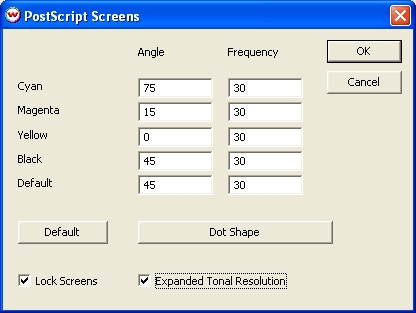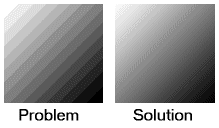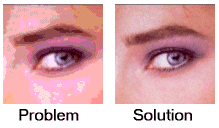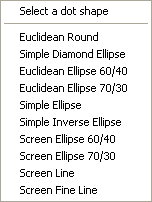
If only spot colors are being printed, or quality process color is not important, basic PostScript Screens may be sufficient. PostScript screen settings are controlled in the Halftone window on the Color Transforms screen.

You may enter the desired halftone screen frequency and angle in these boxes. If you are unsure what to enter, simply pressing Default will set some "reasonable" numbers. Angles are expressed in degrees, and frequency is expressed in lpi (lines per inch). Read more about specifying angles in SoftRIP.
If Lock Screens is checked, these settings will be used regardless of any attempt by PostScript jobs to set their own screens. If it is not checked, these settings will be defaults and will only be used on jobs that do not set their own screens.
Expanded Tonal Resolution can provide substantial improvements to image quality. Resolutions considered high by traditional inkjet users are rather low when compared to 2000 and 4000 dpi imagesetters. When using one of these lower dpi (400, 600, or 720 dpi) devices to make color separations, a common problem is the limitation of "tonal resolution" or "available grays". This shows up as "tonal banding" on the film. When Expanded Tonal Resolution is not checked, your PostScript screens are limited by this formula: "maximum grays = (dpi / lpi) squared". The problem that can result from this limitation is illustrated by the "banded" gradient on the left.

Checking Expanded Tonal Resolution activates a specialized "supercell" technique, which quadruples the available grays, by removing the limitation and producing smooth gradations at higher lpi's. This is illustrated by the smooth gradient on the right.

This Expanded Tonal Resolution technique is not just for gray blends. It also reduces tonal banding in all graphics and images, and in all color spaces, as illustrated above.
Clicking the Dot Shape button presents the options below.

The elliptical dots produced by the "Euclidean Ellipse" selections are most commonly used for screen printing, while the "Euclidean Round" selection is usually more suitable for flexography.